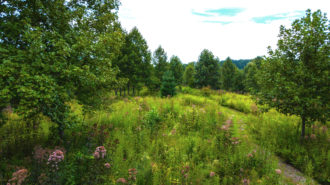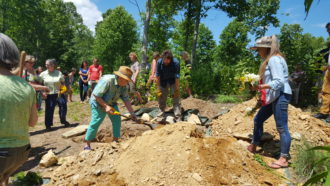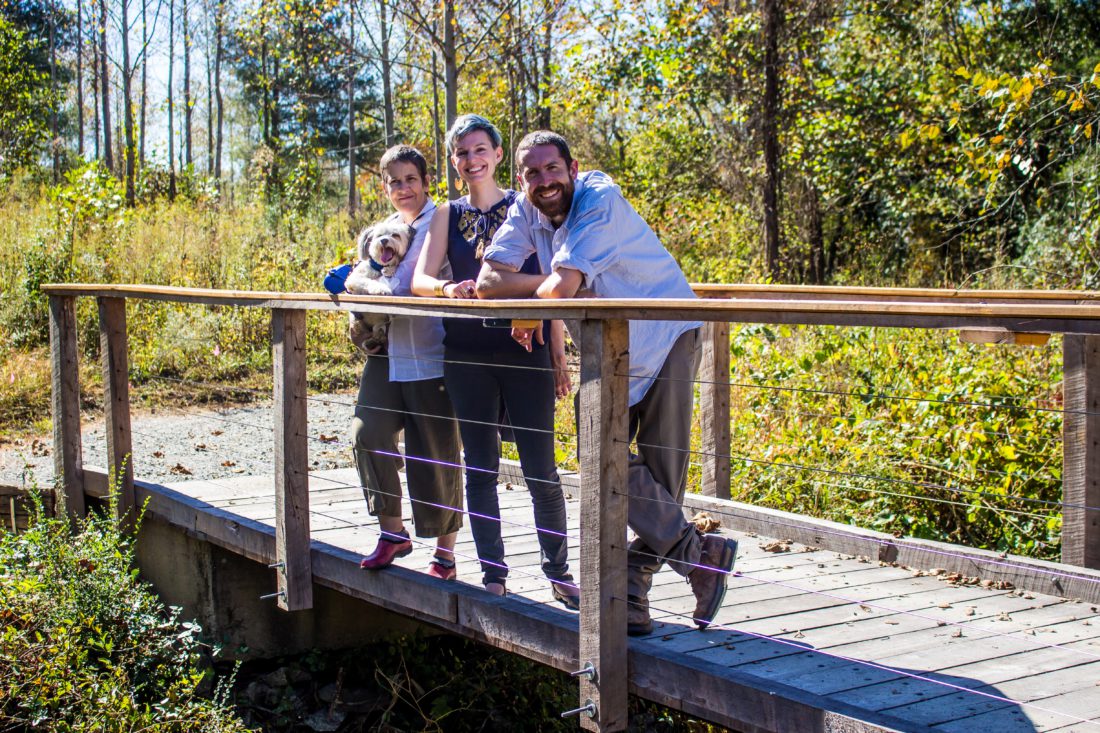On the 11 hilly acres of Carolina Memorial Sanctuary in Mills River, the view encompasses woodland, meadow, wildflowers, native shrubs and McDowell Creek. Birdsong trills through the balmy spring air, the only sound other than the crunch of soles on trails. Hand-hewn wooden benches, placed slightly off the path, offer places for contemplative pause.
Almost fully absorbed into the landscape of North Carolina’s first Green Burial Council-certified conservation burial ground are 53 graves for people of all ages, faiths and backgrounds. Their commonality is a rejection of conventional funeral practices, particularly embalming and standard caskets.
According to the GBC, burials in the United States annually put 4.3 million gallons of embalming fluids — usually containing carcinogenic formaldehyde — 20 million feet of wood, 1.6 million tons of reinforced concrete, 17,000 tons of copper and bronze and 64,500 tons of steel into the ground. Green burial sites such as CMS offer an alternative with less environmental impact.
“Green burial is not new. This is an ancient practice,” says CMS founder Caroline Yongue. “It is the way the majority of people in the world bury their loved ones. Green burial is less costly; it is good for the earth on every level, from death through burial.”
Laid to local rest

The GBC says that cemeteries, preserves and burial grounds can broadly be considered “green” if they care for the dead with minimal environmental impact while conserving natural resources, reducing carbon emissions, protecting worker health and restoring or preserving habitat. Green burial requires the use of nontoxic and biodegradable materials for containers such as caskets, shrouds and urns. In contrast, conventional lawn cemeteries allow embalmed bodies and exotic wood or metal caskets, as well as require concrete, plastic or other vaults or liners to hold them.
The Asheville area offers three GBC-certified burial sites. Two of those, Green Hills Cemetery on New Leicester Highway and Forest Lawn in Candler, are defined as “hybrid” cemeteries, which offer conventional burials in some sections but in other areas prohibit vaults, embalming and non-natural burial containers.
Ron Gortney, superintendent of Green Hills Cemetery, has overseen more than 100 green burials since starting to offer them in 2008. He says that demand for the practice arose partially due to the Great Recession as elderly people sought less expensive alternatives to conventional burial.
“Probably their parents and grandparents were put in a wooden box and buried. Then everything got real commercial and expensive and went over the deep end,” Gortney explains. “This is really the way things used to be. So people were coming back to the old ways.”
As a conservation cemetery, CMS follows a stricter set of guidelines. The entire burial ground only permits green burials, practices integrated pest management in landscaping to reduce chemical use and incorporates native plants and materials to maintain a natural appearance. In addition, CMS granted a permanent conservation easement to Conserving Carolina in October to ensure that the site will remain a natural environment in perpetuity.
Easy to be green?
Many committed to the purity of green burial are wary of what they call “greenwashing,” in which green marketing is deceptively used to promote products or policies as environmentally friendly. “You see it all the time in beauty products and foods,” says Cassie Barrett, operating and marketing director at CMS. “Companies use the word ‘green’ or ‘natural’ to convey more than is true. We urge people who desire a green burial to check with the GBC.”
Gortney says he still offers conventional burials for those who want that choice, but he’s diligent about keeping his green burials completely green. “We abide by [GBC] rules and share information and websites. They have guidelines we have to adhere to, and that’s good,” he says. “A lot of times a place might say it’s a green burial, but they bury metal parts and use a traditional casket, and that’s not what we do for green burial.”
John Christian Phifer, who with Yongue and Barrett is a founding member of the Conservation Burial Alliance, urges those seeking a green burial to keep in mind the practice’s essential goals. The body’s natural return to the land, he says, shouldn’t require much in the way of consumption.
“When you revive a tradition as we have done and start creating a place for these practices to occur, it is inevitable you will have people trying to figure out a way to make money off of that,” Phifer says. He recalls a recent burial where the deceased was buried in a “mushroom suit,” a garment impregnated with fungal spores to break down the body — the same process that happens naturally in dirt.
“They’re so excited to have the option of something natural and have more control over their end and how that looks, they can sometimes go overboard,” Phifer points out. “It is important people know about greenwashing, not only from a conventional funeral business presenting options as green that are not, but also in products that may be ‘green’ but are not necessary.”
Fitting in

At CMS, making a simple green burial available still takes a good deal of work. When Yongue first took possession of the land in December 2015, she recalls, it was “impenetrable” with hundreds of invasive plants and trees. She hired a forestry crew to mulch the invasives and stabilize the ground, remove massive stands of bamboo and build bioswales to capture and filter stormwater runoff. Restoration of the property’s spring head, creek and wetland is still ongoing.
Now, walking the property, Barrett and Yongue point out the meadow, woodland and creekside burial locations that together represent over 280 spots sold since the ground’s first burial in 2016. All graves are dug by hand, many of them by Anthony Pranger, sanctuary steward and head gravedigger, with assistance from five on-call gravediggers, including Barrett.
“There is a very specific method to how we dig graves here,” Barrett explains. “We make three separate piles, and the dirt goes back in the order in which it was removed, so that the topsoil is back on top.”
Some are body burials, some cremated remains; there are also 19 pet graves with both bodies and cremains. “Because cremated remains are very alkaline and salty, if you scatter them, they will kill plants, and if you bury them, they can prevent growth,” Barrett says. “For cremated human or animal remains, we require the use of amendments we provide.”
North Carolina law states that all bodies must be covered by at least 18 inches of earth known as the smell barrier, which prevents animals from detecting the body. Graves at CMS are dug 3 feet down, with roughly another foot of removed dirt mounded on top.
Graves have no vertical markers; instead, many bear a natural stone carved with a name, nestled flat on the ground. Some families also plant memorial trees and shrubs near their loved ones. Light pruning and maintenance takes place on volunteer workdays, but otherwise, nature takes its course. “Some people, even those who want a green burial, have a hard time embracing the wildness,” says Barrett.
Sense of place
Wildness was what appealed to Anne deBuys, who had toured CMS with her partner even before he was diagnosed with a terminal illness. The day after he passed in August 2017, she walked the property with Pranger. “The configuration of the trees was very sheltering in that spot,” she says. “It was a landscape that was peaceful, yet also had a beautiful wildness to it. It just felt right.”
Barrett says deBuys’ experience is common. “You walk around and kind of feel it,” she says. “People know it when they find it.
“One of the beautiful benefits of this type of burial is it empowers people to be hands on and part of the process,” Barrett continues. “It is so helpful for people as part of their grieving to be involved with it.”
Once the body arrives on the property in its shroud or biodegradable container, it can be carried by hand or taken to the gravesite on a trailer pulled by a golf cart. Family and friends process behind the body and are invited to participate in all stages as they are comfortable, including lowering the body into the grave and closing it.
“When people first arrive in the parking lot, there is such heaviness and nervousness in the air; people just aren’t sure of this natural burial thing,” says Yongue. “By the time it is done, things have shifted toward lightness.”
“The atmosphere literally changes before our eyes,” agrees Barrett. “Even people who are skeptical — maybe the conservative siblings of the hippie sister — by the end of the burial, they are amazed at how beautiful, peaceful and natural it is. Over and over, we see real healing begin.”
Because CMS is also a public park, open daily from sunrise to sunset, healing can continue there. Witnessing her partner’s death and burial inspired deBuys to buy the site next to his. “I go about once a week,” she says. “I take a chair, sit at his gravesite and find such comfort and peace there. There are wonderful birds, hawks and a great blue heron. It is a holding space, invested with the sacred as a burial ground.”



Before you comment
The comments section is here to provide a platform for civil dialogue on the issues we face together as a local community. Xpress is committed to offering this platform for all voices, but when the tone of the discussion gets nasty or strays off topic, we believe many people choose not to participate. Xpress editors are determined to moderate comments to ensure a constructive interchange is maintained. All comments judged not to be in keeping with the spirit of civil discourse will be removed and repeat violators will be banned. See here for our terms of service. Thank you for being part of this effort to promote respectful discussion.